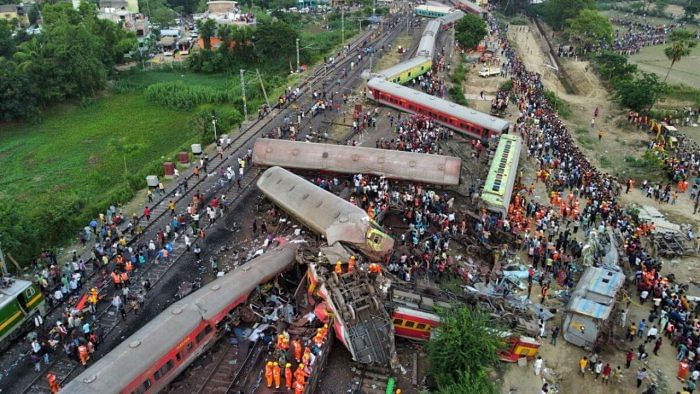
A high-level inquiry has found "wrong signalling" to be the main reason for the Balasore train accident and flagged "lapses at multiple levels" in the signalling and telecommunication (S&T) department, but indicated the tragedy could have been averted if past red flags were reported.
The independent inquiry report submitted by the Commission of Railway Safety (CRS) to the Railway Board said notwithstanding the lapses in signalling work, remedial actions could have been taken by the S&T staff if "repeated unusual behaviour" of switches connecting two parallel tracks were reported to them by the station manager of Bahanaga Bazar, the spot of the accident.
The report also suggested that the non-supply of station-specific approved circuit diagram for the works to replace the electric lifting barrier at level crossing gate 94 at Bahanaga Bazar station was a "wrong step that led to wrong wiring".
It said that a team of field supervisors modified the wiring diagram and failed to replicate it.
The report also said that there was a similar incident on May 16, 2022 at Bankranayabaz station in Khargpur Division of South Eastern Railway, on account of wrong wiring and cable fault.
"Had corrective measures been taken, after this incident, to address the issue of wrong wiring the accident at BNBR would not have taken place," the report said.
The accident on June 2 resulted in the deaths of 292 people and over 1000 were injured.
The CRS report has also said that the initial response to such a disaster should be faster an advised the Railways to review the system of disaster-response in the zonal railways and also the coordination between the zonal railways an various disaster-response forces like NDRF and SDRF.
The report in its conclusion pointed out that the rear-collission was due to the "lapses in the signalling-circuit-alteration" carried out at the north signal 'goomty' in the past and during the execution of the signalling work related to the replacement of electric lifting barrier for level crossing gate 94 at the station.
"These lapses resulted in wrong signalling to the train no. 12841....resulting in the train 12841 traversing on the UP loop line, and eventual rear collision with the goods trains standing there," it said.
The CRS has recommended that a drive should be launched to update the completion signalling wiring diagrams, other documents and lettering of signaling circuits at site.
Standard practices should be followed for carrying out signalling-modification work. It has also said that any alteration to signalling circuits should be carried out with an approved circuit diagram and in the presence of an officer.
It also suggested a separate team should be deployed for checking and testing of modified signalling circuits and functions before restoration and reconnection of the work.
"The central diagram had failed to reflect changes made to the circuit, and yearly inspections made later did not flag that too. So it was not the error of one person, but at least up to five that have come to the fore," an official said.
The officials believe that the findings of the CRS and CBI report will help the Railways in overhauling its safety systems.
"To prevent error by the driver who decides the speed of the train depending on the signal, we are pushing use of anti-collision devices. And for the last two years, ultrasound testing of tracks to detect micro fractures has been a top focus too. Track management is crucial in rail safety. But we are looking at the extensive use of electronic relay systems across the railway network to prevent freak accidents such as what happened in Balasore. These are the most robust, tried and tested systems for rail safety," an official said.
On June 2, 2023, three trains - Bengaluru-Howrah Superfast, Coromandel Express, and a stationary goods train - were involved in a massive triple collision which resulted in a loss of almost 300 human lives. This was termed as the worst railway disaster in India since the 1995 Firozabad train mishap.
With PTI inputs